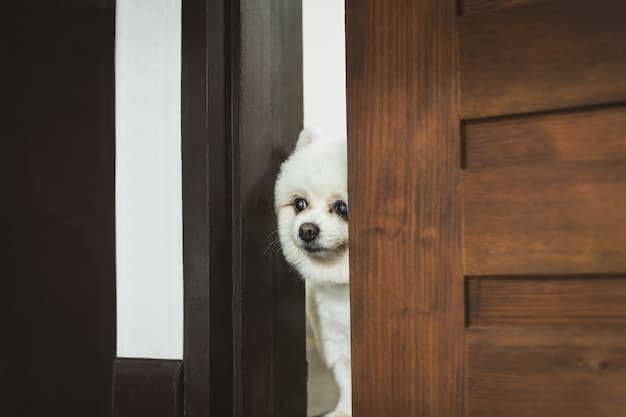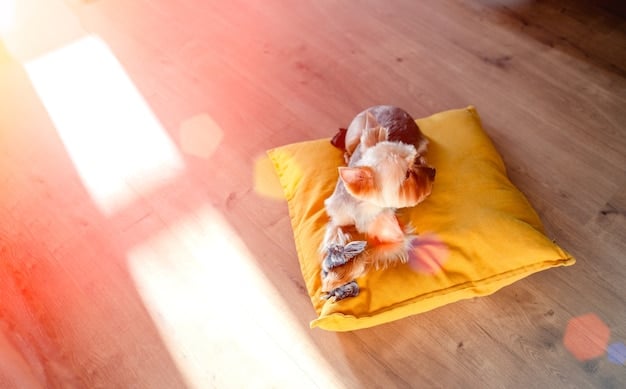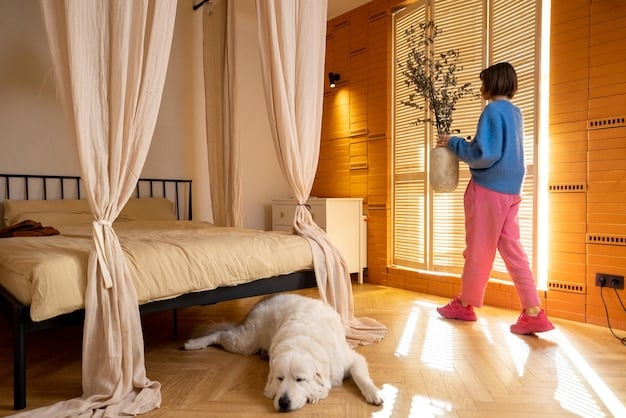Separation Anxiety Solutions: Train Your Dog in 3 Weeks

Separation anxiety in dogs can be managed effectively in about three weeks with consistent training techniques, including creating a safe space, gradual departures, and positive reinforcement, ensuring a calmer, more confident pet.
Is your furry friend struggling with being alone? Discover effective separation anxiety solutions: train your dog to stay calm in 3 weeks with our comprehensive guide.
Understanding Separation Anxiety in Dogs
Separation anxiety is a common issue among dogs, manifesting in various ways when they’re left alone. It’s important to recognize the signs and understand the underlying causes to effectively address this problem.
Understanding separation anxiety is the first step in helping your dog overcome it. It’s not just bad behavior; it’s a sign of distress.
Signs of Separation Anxiety
Dogs with separation anxiety exhibit a range of behaviors when left alone. Recognizing these signs is crucial for proper diagnosis and treatment.
- Excessive barking or howling
- Destructive behavior, like chewing furniture
- Accidents in the house, even when house-trained
- Pacing or restlessness
- Trying to escape
Reasons Behind Separation Anxiety
Several factors can contribute to separation anxiety in dogs. Identifying the root cause can help you tailor your approach to managing the anxiety.

- Change in routine, such as a new work schedule
- Moving to a new home
- Loss of a family member or another pet
- Traumatic experiences when left alone
In summary, understanding the signs and causes of separation anxiety is crucial for implementing effective solutions. Recognizing that it’s a distress response, not disobedience, allows for a more empathetic and effective approach to training.
Creating a Safe Space for Your Dog
A secure and comfortable environment can significantly reduce anxiety in dogs. Designating a specific area as their “safe space” helps them feel more secure when you’re not around.
Establishing a safe space is a cornerstone of managing separation anxiety. This area should be associated with positive experiences and a sense of security.
Setting Up the Safe Zone
Choose a quiet area in your home, away from high-traffic areas. Equip it with comfortable bedding, toys, and familiar scents.
- Use a crate or dog bed as the central point
- Include toys that keep them entertained
- Add an item of clothing with your scent
Positive Associations with the Safe Space
Encourage your dog to spend time in their safe space by making it a positive experience. Use treats, praise, and gentle encouragement to create good associations.
The goal is to make the safe space a refuge, not a punishment. Positive reinforcement is key to achieving this.
Creating a safe space involves strategic setup and positive reinforcement, teaching your dog to associate the area with comfort and security, thereby reducing anxiety when alone.
Gradual Desensitization Techniques
Gradual desensitization involves slowly exposing your dog to being alone in small increments. This helps them become accustomed to your absence without triggering anxiety.
Desensitization is a proven method for reducing anxiety by gradually exposing the dog to the feared scenario.
Starting with Short Separations
Begin by leaving your dog alone for very short periods, such as a few seconds or minutes. Gradually increase the duration as they become more comfortable.
- Start with 1-minute absences
- Gradually increase to 5 minutes, then 10
- Work up to 30 minutes over several days
Avoiding Anxiety Triggers
Pay attention to your dog’s body language and avoid pushing them too quickly. If they show signs of anxiety, reduce the duration of your absences.

It’s crucial to proceed at your dog’s pace, not your own. Patience and consistency are key.
Gradual desensitization requires patience and careful observation, progressively accustoming your dog to being alone in manageable increments, thereby reducing overall separation anxiety.
Using Positive Reinforcement
Reward your dog for calm behavior with treats, praise, or toys. Positive reinforcement reinforces the desired behavior and creates positive associations with being alone.
Positive reinforcement focuses on rewarding desired behaviors, making it a powerful tool in training a dog with separation anxiety.
Rewarding Calm Behavior
When your dog remains calm during your absences, reward them immediately upon your return. This reinforces the idea that being alone is a positive experience.
- Use high-value treats your dog loves
- Offer enthusiastic praise
- Give them a favorite toy
Ignoring Anxious Behavior
Avoid giving attention to anxious behavior. Reinforcing it, even with negative attention, can inadvertently encourage it. If your dog is anxious, wait until they calm down before offering comfort or attention.
It can be hard to ignore your dog when they are upset, but it is necessary to decrease separation anxiety.
Positive reinforcement not only makes dogs associate alone time with positive behavior due to rewards, but also teaches them that panic is unrewarded, which promotes a calmer, less anxious state.
Creating a Consistent Routine
Dogs thrive on routine. Establishing a predictable daily schedule can help reduce anxiety by providing a sense of security and predictability.
Consistency is crucial when helping dogs overcome separation anxiety. A stable routine provides reassurance.
Establishing a Daily Schedule
Set a regular schedule for feeding, walks, playtime, and rest. This helps your dog anticipate what to expect throughout the day.
Try to maintain the routine as closely as possible, even on weekends. This will reinforce the sense of predictability and security.
Managing Departure Cues
Be mindful of the cues that signal your departure, such as picking up your keys or putting on your coat. These can trigger anxiety. Try to desensitize your dog to these cues by performing them at random times without actually leaving.
- Pick up your keys and put them down
- Put on your coat and take it off
- Open and close the door without leaving
A consistent routine helps to predict the day’s events, including their owner’s coming and going, and decreases the uncertainty element which results in lower separation anxiety and a calmer dog overall.
Seeking Professional Help
If your dog’s separation anxiety is severe or doesn’t improve with training, consider seeking professional help from a veterinarian or certified dog trainer. They can provide personalized guidance and recommendations.
Professional help is essential when separation anxiety is severe or unresponsive to basic training techniques.
Consulting with a Veterinarian or Professional Dog Trainer
A veterinarian can rule out any underlying medical conditions that may be contributing to the anxiety. A certified dog trainer can provide specialized training techniques tailored to your dog’s needs.
Veterinarians can offer medication choices, such as anti-anxiety drugs, and trainers may introduce cutting-edge treatment approaches.
Medication Options
In some cases, medication may be necessary to help manage severe anxiety. Your veterinarian can prescribe appropriate medications and monitor your dog’s response.
Don’t hesitate to seek help if your dog continues to struggle. Professional guidance can make a significant difference.
Seeking professional assistance such as consulting with a veterinarian or a certified dog trainer can reveal other treatments or tactics that might be successful when other methods have stalled.
Maintaining Progress and Preventing Relapses
Once your dog’s separation anxiety is under control, it’s important to maintain the progress and prevent relapses. Continue to reinforce positive behaviors and stick to a consistent routine.
Long-term management is essential to prevent separation anxiety from returning.
- Keep up with regular training sessions
- Continue to provide a safe space
- Maintain a consistent routine
Addressing Setbacks
If your dog experiences a setback, don’t get discouraged. Simply go back to the basics and reinforce the training techniques that have been successful in the past. In the event of problems, persistence is essential.
By maintaining consistency and addressing setbacks promptly, you can help your dog lead a happier, less anxious life.
Maintenance and relapse prevention are important for long-term separation anxiety management and entail continuous reinforcement of the skills learned, keeping to a routine, and dealing successfully with any reversals to guarantee that the dog remains calm and secure.
| Key Point | Brief Description |
|---|---|
| 🏠 Safe Space | Designate a secure, comfortable area with familiar items. |
| 🚶 Gradual Absences | Start with short departures, increasing the time slowly. |
| ✅ Positive Reinforcement | Reward calm behavior with treats and praise. |
| 📅 Consistent Routine | Adhere to a regular daily schedule for security. |
Frequently Asked Questions
▼
With consistent training, noticeable improvement can be seen in about three weeks. However, full resolution may take several months, depending on the severity of the anxiety.
▼
Common signs include excessive barking, destructive behavior (like chewing), accidents in the house, pacing, and attempts to flee when left alone.
▼
Choose a quiet area, add a comfortable bed, familiar toys, and an item with your scent. Encourage positive associations through treats and praise.
▼
It involves gradually exposing your dog to being alone in small increments. Start with brief separations and slowly increase the duration to reduce anxiety.
▼
If the anxiety is severe or doesn’t improve with basic training, consult a veterinarian or certified dog trainer for personalized guidance and potential medication options.
Conclusion
By understanding the causes and signs of separation anxiety, creating a safe space, using gradual desensitization techniques, and maintaining a consistent routine, you can greatly improve your dog’s well-being and help them learn to stay calm when you’re away. If needed, don’t hesitate to seek professional help to ensure your furry friend lives a happier, less anxious life.





